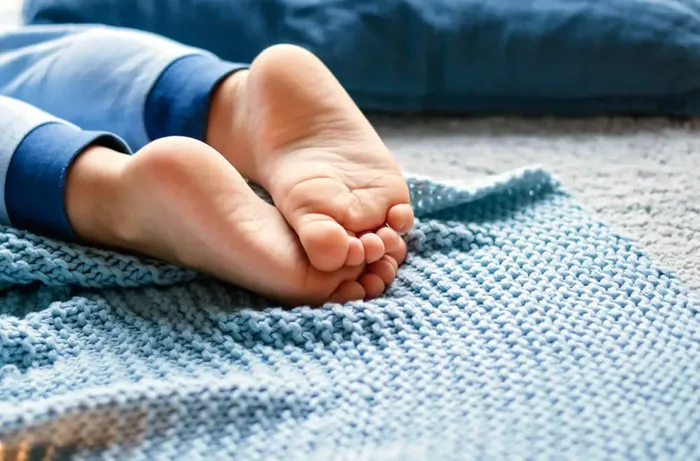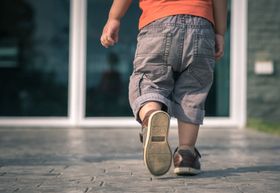Why Are My Baby’s Feet Purple? Common Causes and What to Do
Did your baby's tiny feet turn puple all of a sudden? No need to panic; let's explore the causes.
Updated March 26, 2025.

Did your baby’s feet suddenly turn purple or bluish? Don’t panic—most cases are harmless, but some need attention. We’ll cover age-specific causes (newborns to toddlers) and when to call a doctor.
Every parent marvels at their newborn’s tiny feet—so seeing purple toes, blue soles, or mottled skin can be scary. Most often, it’s just immature circulation, but let’s explore all possibilities.
» Ready for those first steps? Get your little one the best orthopaedic shoes
4 Common Causes of Purple Feet in Babies
1. Immature Circulatory System
According to the Cincinnati Children's Hospital, a newborn's circulatory system is still developing [1]. The blood vessels in their hands and feet tighten to keep their core warm, which can cause purple feet, a condition called acrocyanosis.
2. Skin Thickness
Your baby's skin is thinner, which can make the underlying blood vessels visible with a purple hue. It's especially apparent in areas with less fat and muscle—like the feet and hands. It's also more easily noticeable in preemies or low-birth-weight babies.
» Find out what it means when a baby's feet are constantly sweaty
3. Raynaud’s Phenomenon
Raynaud's Phenomenon is a rare occurrence where extremities change colours because of constricted blood vessels. It happens due to cold temperatures or stress [2].
If you're concerned about colour changes in your baby's feet, especially if they turn purple when held or have a delayed return to their normal colour after warming, schedule an appointment with their pediatrician.
Be sure to describe the colour changes you've observed when they happen, as well as any other relevant information.
4. Skin Conditions and Allergies
There are a few skin conditions or allergies that could cause purple colour in your baby's feet. The most common ones are:
- Hives that are characterised by raised red or purple patches.
- Ischemic foot that is characterised by cold and pulseless feet.
- Eczema that is characterised by dry, inflamed skin.
» Learn what to look for when dealing with shoe allergies in children
What You Can Do About Your Baby's Purple Feet
Acrocyanosis often resolves on its own as the baby warms up, but here are some general guidelines:
- Keep your baby warm by swaddling them in blankets or using a towel immediately after bathing. This helps maintain body temperature and reduce the occurrence of acrocyanosis.
- Ensure that the discolouration is limited to the extremities (hands and feet) and does not affect central areas like the lips or tongue. Central cyanosis can mean a serious condition and should be checked by a healthcare provider.
- Generally, acrocyanosis requires no medication. It is a benign condition that resolves as your little one grows and their circulatory system matures.
» Learn how to check if your little one is walking correctly
When to See a Doctor
Here are situations when you should consult a doctor:
If the purple colouration persists beyond the first 24-48 hours of life, it's advisable to seek medical attention to rule out any underlying issues.
If the baby's lips, gums, or tongue turn blue, this could indicate low oxygen levels and require immediate medical evaluation.
If your baby shows signs of breathing difficulties, lethargy, irritability, fever, poor feeding, or decreased consciousness alongside the colour change, seek medical help immediately.
If your baby's skin develops a purplish, marbled appearance (mottling) after warming up, consult a healthcare professional.
Always trust your instincts; if something feels off or you're concerned about your baby's health, it's best to consult with a doctor for peace of mind and to ensure your baby's well-being
» Check out the signs your baby's feet are swollen
Cheerful Strides and Healthy Feet
Recognising early signs and knowing possible causes of why your baby's feet have changed colour is as crucial as picking the proper footwear. If you notice persistent discolouration, breathing troubles or lethargy, visit a healthcare professional to rule out any serious medical issues.
Orthopaedic shoes from the First Walkers collection promote your baby's healthy foot development. Visit the website and buy your child the essential support for growth and comfort.
» Help your kid's feet in growing healthy: Get orthopaedic shoes
References:
- “Cyanosis | Symptoms, Diagnosis & Treatment.” Available: https://www.cincinnatichildrens.org/health/c/cyanosis
- N. S. C. and O. Branch, “Raynaud’s Phenomenon,” National Institute of Arthritis and Musculoskeletal and Skin Diseases, Feb. 18, 2025. Available: https://www.niams.nih.gov/health-topics/raynauds-phenomenon
Disclaimer: First Walkers' information is intended for educational and informational purposes related to toddler footwear and feet. We encourage you to consider individual circumstances and consult qualified orthopedists about specific conditions.
Related Articles

9 Best Hiking Boots for Toddlers: Ensuring Comfort and Safety
Jasrah Javed
December 6, 2024

How to Prevent Kids Foot Injuries: Essential Tips for Parents
Leah Alexander
March 6, 2024

7 Fun Activities for Kids and Parents Bonding
First Walkers AUS
December 6, 2024

Online Shoe Shopping Guide for Kids: Finding the Perfect Fit
George Croft
June 13, 2024

Effects of Improperly Sized Shoes on Children and Toddlers
George Croft
December 6, 2024